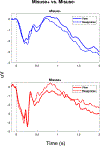Neurophysiological Deficits During Reappraisal of Negative Emotional Stimuli in Opioid Misuse
- PMID: 35393080
- PMCID: PMC9167218
- DOI: 10.1016/j.biopsych.2022.01.019
Neurophysiological Deficits During Reappraisal of Negative Emotional Stimuli in Opioid Misuse
Abstract
Background: Opioid misuse is hypothesized to compromise the ability to regulate negative emotions, as manifested through visceral and peripheral physiological signals. However, neurophysiological impairment of top-down cognitive emotion regulation in opioid misuse has not previously been shown.
Methods: Patients with chronic pain who had been taking opioids for 90 days or longer (N = 149; female, n = 98) underwent a negative emotion regulation task with electroencephalography. Participants were instructed to view or reappraise negative images presented for 3 seconds. Using a validated cutoff score on the Current Opioid Misuse Measure, participants were classified as exhibiting aberrant drug-related behavior consistent with opioid misuse (MISUSE+) or as being low risk for opioid misuse (MISUSE-). Participants reported their craving in response to negative emotions over the past week.
Results: We observed a group × condition interaction (p = .003) such that the MISUSE- group decreased the late positive potential of the electroencephalography during reappraisal, whereas the MISUSE+ group showed increased late positive potential during reappraisal. This deficit in negative emotion regulation remained significant after controlling for an array of potential confounding variables, including opioid dose, pain, and depression. Heightened late positive potential during reappraisal was associated with more severe opioid craving.
Conclusions: Opioid misuse may occasion top-down deficits in emotional regulation that begin as early as 400 ms after presentation of negative stimuli. It remains unknown whether emotion dysregulation is the cause, correlate, or consequence of opioid misuse. Nonetheless, targeting emotion dysregulation in opioid misuse with reappraisal-focused interventions may represent an important treatment approach.
Keywords: Chronic pain; Craving; Emotion regulation; Opioid misuse; Opioid use disorder; Reappraisal.
Copyright © 2022 Society of Biological Psychiatry. All rights reserved.
Conflict of interest statement
Figures


Comment in
-
Emotion Dysregulation and Opioid Misuse.Biol Psychiatry. 2022 Jun 15;91(12):1005-1007. doi: 10.1016/j.biopsych.2022.04.007. Biol Psychiatry. 2022. PMID: 35654558 No abstract available.
References
-
- Vowles KE, McEntee ML, Julnes PS, Frohe T, Ney JP, van der Goes DN (2015): Rates of opioid misuse, abuse, and addiction in chronic pain: a systematic review and data synthesis. Pain 156: 569–576. - PubMed
-
- Sullivan MD (2018): Depression effects on long-term prescription opioid use, abuse, and addiction. Clin J Pain 34: 878–884. - PubMed
-
- Rogers AH, Zvolensky MJ, Ditre JW, Buckner JD, Asmundson GJ (2021): Association of opioid misuse with anxiety and depression: A systematic review of the literature. Clin Psychol Rev 101978. - PubMed
Publication types
MeSH terms
Substances
Grants and funding
LinkOut - more resources
Full Text Sources
Medical
Miscellaneous

